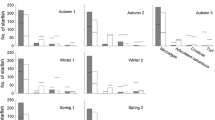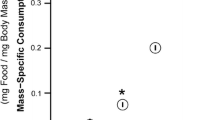Abstract
The foraging behavior of the bucktooth parrotfish Sparisoma radians was studied in seagrass beds off St. Croix, US Virgin Islands and in laboratory preference tests. Thalassia testudinum was the dominant item in the field diet with the epiphytized distal portion of the blades most favored. Other seagrasses, Syringodium filiforme and Halodule wrightii, were taken in relation to their abundance. Several algae were also eaten, particularly Halimeda spp. and Penicillus spp. Although abundances of the algae varied, the fish maintained a steady mixture of plant species in their diet. Laboratory feeding tests for various plants presented in pairs showed clear preferences in nearly all cases. The preference hierarchy was (1) T. testudinum with epiphytes, (2) H. wrightii, (3) T. testudinum without epiphytes, (4) S. filiforme, and the algae, (5) Dictyota divaricata, (6) Enteromorpha flexuosa, (7) Caulerpa mexicana, (8) Halimeda incrassata and (9) Penicillis pyriformis. Preference did not vary significantly with satiation. The “catch per unit effort” (kilocalories absorbed per bite) was calculated for each plant, using (a) absorption values calculated for S. radians fed the different plants, (b) the calorific values for tested plants, and (c) an estimate of the amount of material taken per bite. The ranking of catch per unit effort closely paralleled the preference hierarchy with the exception of C. mexicana which has a toxin. Fish fed diets of single plants, mixed plant diet, and starved controls showed differential survival which paralleled the preference hierarchy, the most preferred plants leading to longest survival. Comparison of laboratory results with field feeding behavior shows that inclusion of plants in the diet is not related directly to preference rank, availability or survival value, but that the fish deliberately eat a variety of plants presumably which maintains balanced diet. This result indicates that models of optimal foraging for herbivores should include nutrient constraints and avoidance of toxins in order to predict accurately the behavior of an animal in the field.
Similar content being viewed by others
Literature Cited
Ballantine, D. L.: The distribution of algal epiphytes on macrophyte hosts offshore from La Parguera, Puerto Rico. Bot. Mar. 22, 107–111 (1979)
Ballantine, D. L. and H. J. Humm: Benthic algae of the Anclote estuary I. Epiphytes of seagrass leaves. Fla Scient 38, 150–162 (1975)
Belovsky, G. E.: Diet optimization in a generalist herbivore: the moose. Theor. Pop. Biol. 14, 105–134 (1978)
Charnov, E. L.: Optimal foraging: attack strategy of a mantid. Am. Nat. 110, 141–151 (1976)
Condrey, R. E., J. G. Gosselink and H. J. Bennett: Comparison of the assimilation of different diets by Penaeus setiferus and P. aztecus. Fish. Bull. U.S. 70, 1281–1292 (1972)
Conover, R. J.: Assimilation of organic matter by zooplankton. Limnology and Oceanography 11, 338–345 (1966)
Dawes, C. J. and R. H. Goddard: Chemical composition of the wound plug and entire plants for species of the coenocytic green alga, Caulerpa. J. exp. mar. Biol. Ecol. 35, 259–263 (1978)
Dawes, C. J. and J. M. Lawrence: The effects of blade removal on the proximate composition of the rhizome of the seagrass Thalassia testudinum Banks ex Kónig. Aquat. Bot. 7, 255–266 (1980)
Dawes, C.J., K. Bird, M. Durako, R. Goddard, W. Hoffman and R. McIntosh: Chemical fluctuations due to seasonal and cropping effects on an algal-seagrass community. Aquat. Bot. 6, 79–86 (1979)
Doty, M. S. and G. Aguilar-Santos: Caulerpicin, a toxic constituent of Caulerpa. Nature, Lond. 211, 990 (1966)
Doty, M. S. and G. Aguilar-Santos: Transfer of toxic algal substances in marine food chains. Pacif. Sci. 24, 351–355 (1970)
Freeland, W. J. and D. H. Janzen: Strategies in herbivory by mammals: the role of plant secondary compounds. Am. Nat. 108, 269–289 (1974)
Hobson, E. S.: Feeding relationships of teleostean fishes on coral reefs in Kona, Hawaii. Fish. Bull. U.S. 72, 915–1031 (1974)
Humm, H. J.: Epiphytes on the seagrass, Thalassia testudinum, in Florida. Bull. mar. Sci. 14, 306–341 (1964)
Ivlev, V. S.: Experimental ecology of the feeding of fishes. New Haven: Yale Univ. Press 1961
Jacobs, J.: Quantitative measurement of food selection. Oeccologia 14, 413–417 (1974)
Krebs, J. R.: Optimal foraging: decision rules for predators. In: Behavioral ecology, pp 23–63, Ed. by J. R. Krebs and N. B. Davies, Sunderland, Mass.: Sinauer 1978
Lawrence, J. M.: On the relationships between marine plants and sea urchins (Echinodermata: Echinoidea). Oceanogr. mar. Biol. A. Rev. 13, 213–286 (1975)
Lobel, P. S.: Herbivory by damselfishes and their role in coral reef community ecology. Bull. mar. Sci. 30, 273–289 (1980)
Lobel, P. S.: Trophic biology of herbivorous reef fishes: alimentary pH and digestive capabilities. J. of Fish Biol. (In press)
Lowe, E. F. and J. M. Lawrence. Absorption efficiencies of Lytechinus variegatus (Lamarck) (Echinodormata: Echinodea) for selected marine plants. J. exp. mar. Biol. Ecol. 21, 223–234 (1976)
Ogden, J. C. and P. S. Lobel: The role of herbivorous fishes and urchins in coral reef communities. Envir. Biol. Fish. 3, 46–63 (1978)
Ogden, J. C. and J. C. Zieman: Ecological aspects of coral reefseagrass bed contacts in the Caribbean. Proceedings Third International Coral Reef Symposium 1, 377–382 (1977)
Paine, R. T.: The measurement and application of the calorie to ecological problems. A. Rev. Ecol. Syst. 2, 145–164 (1971)
Paine, R. T. and R. L. Vadas: Calorific values of benthic marine algae and their postulated relation to invertebrate food preference. Mar. Biol. 4, 79–86 (1969)
Paloheimo, J. E.: Indices of food preference by a predator. J. Fish. Res. Bd Can. 36, 470–473 (1979)
Pulliam, H. R.: On the theory of optimal diets. Am. Nat. 108, 59–74 (1974)
Pulliam, H. R.: Diet optimization with nutrient constraints. Am. Nat. 109, 765–768 (1975)
Pyke, G. H., H. R. Pulliam and E. L. Charnov: Optimal foraging theory and tests. Q. Rev. Biol. 52, 137–154 (1977)
Randall, J. E.: A redescription of Sparisoma automarium (Poey), a valid West Indian parrotfish. Notul. Nat. No. 378, 1–9 (1965)
Randall, J. E.: Food habits of reef fishes of the West Indies. Stud. trop. Oceanogr. Miami 5, 665–847 (1967)
Randall, J. E.: Caribbean reef fishes, 319 pp. New Jersey: T. F. H., Press 1968
Reyes-Vasques, G.: Studies on the diatom flora living on Thalassia testudinum Konig in Biscayne Bay, Florida. Bull. mar. Sci. 20, 105–134 (1970)
Robertson, D. R. and R. R. Warner: Sexual patterns in the labroid fishes of the Western Caribbean. II. The parrotfishes (Scaridae). Smithson. Contr. Zool. No. 255, 1–26 (1978)
Schoener, T. W.: Theory of feeding strategies. A. Rev. Ecol. Syst. 2, 369–404 (1971)
Sokal, R. R. and F. J. Rohlf: Biometry. San Francisco: W. H. Freeman and Co. 1969
Stein, R. A.: Selective predation, optimal, foraging, and the predator-prey interaction between fish and crayfish. Ecol. 58, 1237–1253 (1977)
Thayer, G. W. and M. W. LaCroix: Utilixation of energy sources by a tropical-subtropical seagrass bed herbivore. N.M.F.S. Annual Report E.R.D.A., 1–12 (1977)
Vadas, R. L.: Preferential feeding: an optimization strategy in sea urchins. Ecol. Monogr. 47, 337–371 (1977)
Weatherley, A. H.: Factors affecting maximization of fish growth. J. Fish. Res. Bd Can. 33 1046–1058 (1976)
Weinstein, M. P. and K. L. Heck, Jr.: Ichthyofauna of seagrass meadows along the Caribbean coast of Panama and in the Gulf of Mexico: composition, structure and community ecology. Mar. Biol. 50, 97–107 (1979)
Westoby, M.: An analysis of diet selection by large generalist herbivores. Am. Nat. 108, 290–304 (1974)
Westoby, M.: What are the biological bases of varied diets? Am. Nat. 112, 627–631 (1978)
Zeitoun, I. H., D. E. Ullrey, W. T. Magee, J. L. Gill and W. G. Bergen: Quantifying nutrient requirements of fish. J. Fish. Res. Bd Can. 33, 167–172 (1976)
Author information
Authors and Affiliations
Additional information
Communicated by J. M. Lawrence, Tampa
Rights and permissions
About this article
Cite this article
Lobel, P.S., Ogden, J.C. Foraging by the herbivorous parrotfish Sparisoma radians . Mar. Biol. 64, 173–183 (1981). https://doi.org/10.1007/BF00397106
Accepted:
Issue Date:
DOI: https://doi.org/10.1007/BF00397106




